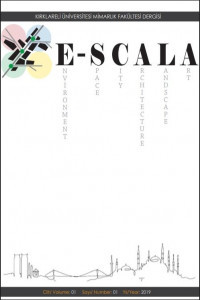Cohen, Papanek ve Banham Üzerinden Mimarlıkta Ekoloji Kavramının Analizi
Analyzing the Context of Architecture and Ecology via Cohen, Papanek, and Banham
ecology, architecture, contextualism, cohen, papanek, banham,
___
- Banham, R., 1971, Los Angeles: The Architecture of Four Ecologies, An Ecology for Architecture, pp. 235-244.
- Banham, R., 2017, Architecture of the Well-Tempered Environment, The Architectural Press, London.
- Banham, R., 2020, Megastructure: Urban Futures of the Recent Past, Monacelli Press.
- Cohen, S., 1974, Physical Context/Cultural Context: Including It All, A Journal For Ideas and Criticism in Architecture, pp. 1-40.
- Özten, Ü. ve Anay, H., 2017, Contextualism as a Basis for an Environmental Architectural Design in a Globalized World, Proceedings of 56 th IASTEM International Conference, New York, USA, ss. 11-15.
- Özten, Ü., Anay, H., 2020, Giriş: Mimari Bağlamsalcılık, Mimari Bağlamsalcılık, Eskişehir Osmangazi Üniversitesi Yayınları, Eskişehir, ss. 12-19.
- Papanek, V., 1972, Design For The Real World, Environmental Design: Pollution, Crowding, Ecology, Bantam Books, pp. 241-275.
- Rowe, C. ve Koetter, F., 1978, Collage City. MIT Press.
- Rooyen, X., V., 2018, Megaform versus Open Structure or the Legacy of Megastructure, Histories of Postwar Architecture, Vol 1, No 3, pp. 30-49.
- Zuddas, F., 2018, The eccentric outsider: Or, why Reyner Banham dismissed Giuseppe Samonà’s mega-project for the University of Cagliari, Histories of Postwar Architecture, Vol 1, No 3, pp. 50-71.
- Başlangıç: 2022
- Yayıncı: Kırklareli Üniversitesi
Cohen, Papanek ve Banham Üzerinden Mimarlıkta Ekoloji Kavramının Analizi
Hatice Tuğba KARAYAMA, Yasemin HEKİMOĞLU
1930-1950 Yılları Arası Kırklareli Konutlarının Cephe Özelliklerinin Belirlenmesi
H. Meltem GÜNDOĞDU, Cansu GENÇ
Taşkın Risk Yönetim Stratejilerinin SEÇTİK Modeli ile Değerlendirilmesi: Edirne
Kentlileşme Düzeyinin Ölçülebilmesine Yönelik Drake-Benzeri Denklem Temelli Bir Değerlendirme
Loft Kavramı ve Yapıların Loft Dönüşüm Ölçütleri Kapsamında Örnekler Üzerinden İncelenmesi
Ecem Nur UYAR, Gökben PALA AZSÖZ
